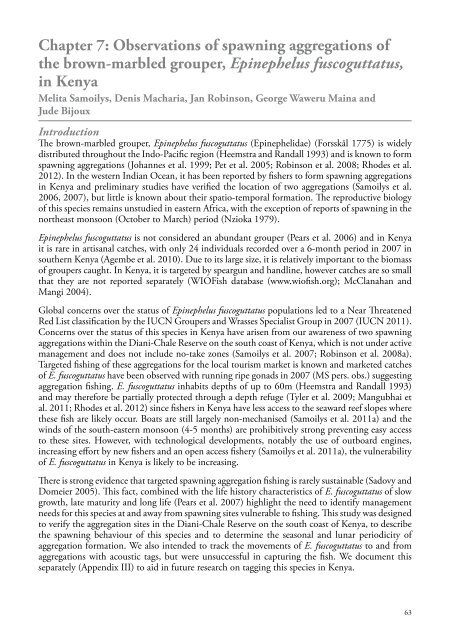WIOMSA-CORDIO spawning book Full Doc 10 oct 13.pdf
WIOMSA-CORDIO spawning book Full Doc 10 oct 13.pdf
WIOMSA-CORDIO spawning book Full Doc 10 oct 13.pdf
Create successful ePaper yourself
Turn your PDF publications into a flip-book with our unique Google optimized e-Paper software.
Chapter 7: Observations of <strong>spawning</strong> aggregations ofthe brown-marbled grouper, Epinephelus fuscoguttatus,in KenyaMelita Samoilys, Denis Macharia, Jan Robinson, George Waweru Maina andJude BijouxIntroductionThe brown-marbled grouper, Epinephelus fuscoguttatus (Epinephelidae) (Forsskål 1775) is widelydistributed throughout the Indo-Pacific region (Heemstra and Randall 1993) and is known to form<strong>spawning</strong> aggregations (Johannes et al. 1999; Pet et al. 2005; Robinson et al. 2008; Rhodes et al.2012). In the western Indian Ocean, it has been reported by fishers to form <strong>spawning</strong> aggregationsin Kenya and preliminary studies have verified the location of two aggregations (Samoilys et al.2006, 2007), but little is known about their spatio-temporal formation. The reproductive biologyof this species remains unstudied in eastern Africa, with the exception of reports of <strong>spawning</strong> in thenortheast monsoon (October to March) period (Nzioka 1979).Epinephelus fuscoguttatus is not considered an abundant grouper (Pears et al. 2006) and in Kenyait is rare in artisanal catches, with only 24 individuals recorded over a 6-month period in 2007 insouthern Kenya (Agembe et al. 20<strong>10</strong>). Due to its large size, it is relatively important to the biomassof groupers caught. In Kenya, it is targeted by speargun and handline, however catches are so smallthat they are not reported separately (WIOFish database (www.wiofish.org); McClanahan andMangi 2004).Global concerns over the status of Epinephelus fuscoguttatus populations led to a Near ThreatenedRed List classification by the IUCN Groupers and Wrasses Specialist Group in 2007 (IUCN 2011).Concerns over the status of this species in Kenya have arisen from our awareness of two <strong>spawning</strong>aggregations within the Diani-Chale Reserve on the south coast of Kenya, which is not under activemanagement and does not include no-take zones (Samoilys et al. 2007; Robinson et al. 2008a).Targeted fishing of these aggregations for the local tourism market is known and marketed catchesof E. fuscoguttatus have been observed with running ripe gonads in 2007 (MS pers. obs.) suggestingaggregation fishing. E. fuscoguttatus inhabits depths of up to 60m (Heemstra and Randall 1993)and may therefore be partially protected through a depth refuge (Tyler et al. 2009; Mangubhai etal. 2011; Rhodes et al. 2012) since fishers in Kenya have less access to the seaward reef slopes wherethese fish are likely occur. Boats are still largely non-mechanised (Samoilys et al. 2011a) and thewinds of the south-eastern monsoon (4-5 months) are prohibitively strong preventing easy accessto these sites. However, with technological developments, notably the use of outboard engines,increasing effort by new fishers and an open access fishery (Samoilys et al. 2011a), the vulnerabilityof E. fuscoguttatus in Kenya is likely to be increasing.There is strong evidence that targeted <strong>spawning</strong> aggregation fishing is rarely sustainable (Sadovy andDomeier 2005). This fact, combined with the life history characteristics of E. fuscoguttatus of slowgrowth, late maturity and long life (Pears et al. 2007) highlight the need to identify managementneeds for this species at and away from <strong>spawning</strong> sites vulnerable to fishing. This study was designedto verify the aggregation sites in the Diani-Chale Reserve on the south coast of Kenya, to describethe <strong>spawning</strong> behaviour of this species and to determine the seasonal and lunar periodicity ofaggregation formation. We also intended to track the movements of E. fuscoguttatus to and fromaggregations with acoustic tags, but were unsuccessful in capturing the fish. We document thisseparately (Appendix III) to aid in future research on tagging this species in Kenya.63


















